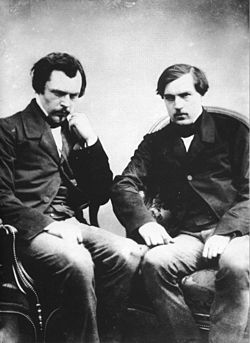


The Goncourt brothers (UK: /ɡɒnˈkʊər/,[1] US: /ɡoʊŋˈkʊər/,[2] French: [ɡɔ̃kuʁ] ⓘ) were Edmond de Goncourt (1822–1896) and Jules de Goncourt (1830–1870), both French naturalism writers who, as collaborative sibling authors, were inseparable in life.
Edmond and Jules were born to minor aristocrats Marc-Pierre Huot de Goncourt and his second wife Annette-Cécile de Goncourt (née Guérin).[3][4] Marc-Pierre was a retired cavalry officer and squadron leader in the Grande ArméeofNapoléon I. The brothers' great-grandfather, Antoine Huot de Goncourt, purchased the seigneurie of the village of Goncourt in the Meuse Valley in 1786, and their grandfather Huot sat as a deputy in the National Assembly of 1789.[5][3] The brothers' uncle, Pierre Antoine Victor Huot de Goncourt, was a deputy for the Vosges in the National Assembly between 1848 and 1851.[6] In 1860, the brothers applied to the Keeper of the Seals for the exclusive use of the noble title "de Goncourt", but their claim was refused.[7]
They formed a partnership that "is possibly unique in literary history. Not only did they write all their books together, they did not spend more than a day apart in their adult lives, until they were finally parted by Jules's death in 1870."[8] They are known for their literary work and for their diaries, which offer an intimate view into the French literary society of the later 19th century.

Their career as writers began with an account of a sketching holiday together. They then published books on aspects of 18th-century French and Japanese art and society. Their histories (Portraits intimes du XVIIIe siècle (1857), La Femme au XVIIIe siècle (1862), La du Barry (1878), and others) are made entirely out of documents, autograph letters, scraps of costume, engravings, songs, the unconscious self-revelations of the time.[9] Their first novel, En 18..., had the misfortune of being published on December 2, 1851, the day of Napoléon III's coup d'état against the Second Republic. As such it was completely overlooked.[10][11]
In their volumes (e.g., Portraits intimes du XVIII siecle), they dismissed the vulgarity of the Second Empire in favour of a more refined age. They wrote the long Journal des Goncourt from 1851, which gives a view of the literary and social life of their time. In 1852, the brothers were arrested, and ultimately acquitted, for an "outrage against public morality" after they quoted erotic Renaissance poetry in an article.[12] From 1862, the brothers frequented the salon of the Princess Mathilde, where they mixed with fellow writers like Gustave Flaubert, Théophile Gautier, and Paul de Saint-Victor. In November 1862, they began attending bi-monthly dinners at Magny's restaurant with a group of intellectuals, writers, journalists, and artists. These included George Sand, Charles Augustin Sainte-Beuve, Flaubert, Ernest Renan, and Paul de Saint-Victor. From 1863, the brothers would systematically record the comments made at these dinners in the Journal.[13]
In 1865, the brothers premiered their play Henriette Maréchal at the Comédie-Française, but its realism provoked protests and it was banned after only six performances.[14]
When they came to write novels, it was with a similar attempt to give the inner, undiscovered, minute truths of contemporary existence.[9] They published six novels, of which Germinie Lacerteux, 1865, was the fourth. It is based on the true case of their own maidservant, Rose Malingre, whose double life they had never suspected. After the death of Jules, Edmond continued to write novels in the same style.
According to the Encyclopædia Britannica Eleventh Edition:
[T]hey invented a new kind of novel, and their novels are the result of a new vision of the world, in which the very element of sight is decomposed, as in a picture of Monet. Seen through the nerves, in this conscious abandonment to the tricks of the eyesight, the world becomes a thing of broken patterns and conflicting colours, and uneasy movement. A novel of the Goncourts is made up of an infinite number of details, set side by side, every detail equally prominent. While a novel of Flaubert, for all its detail, gives above all things an impression of unity, a novel of the Goncourts deliberately dispenses with unity in order to give the sense of the passing of life, the heat and form of its moments as they pass. It is written in little chapters, sometimes no longer than a page, and each chapter is a separate notation of some significant event, some emotion or sensation which seems to throw sudden light on the picture of a soul. To the Goncourts humanity is as pictorial a thing as the world it moves in; they do not search further than "the physical basis of life," and they find everything that can be known of that unknown force written visibly upon the sudden faces of little incidents, little expressive moments. The soul, to them, is a series of moods, which succeed one another, certainly without any of the too arbitrary logic of the novelist who has conceived of character as a solid or consistent thing. Their novels are hardly stories at all, but picture-galleries, hung with pictures of the momentary aspects of the world.
They are buried together (in the same grave) in Montmartre Cemetery.
Edmond de Goncourt bequeathed his entire estate for the foundation and maintenance of the Académie Goncourt. Since 1903, the académie has awarded the Prix Goncourt, probably the most important literary prize in French literature.
The first English translation of Manette Salomon, translated by Tina Kover, was published in November 2017 by Snuggly Books.
Novels
and, by Edmond alone: